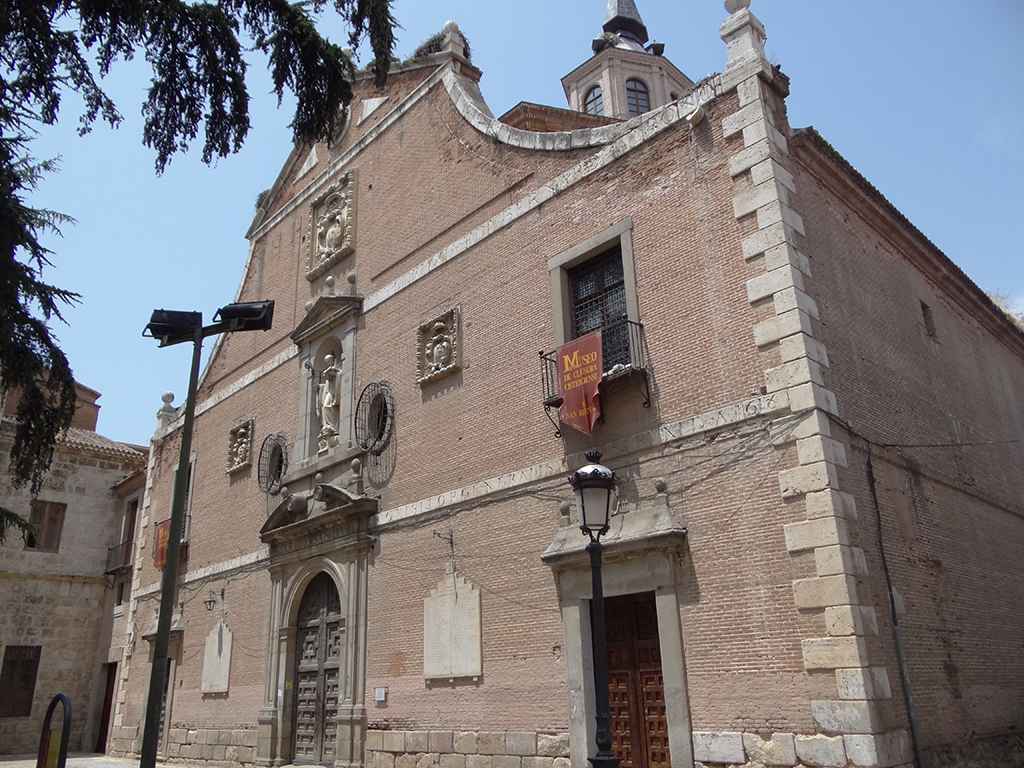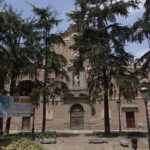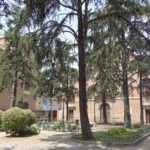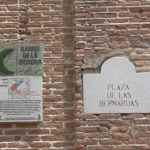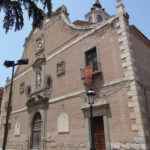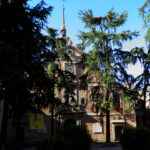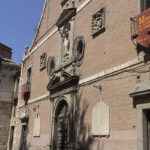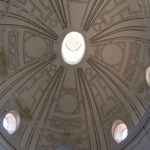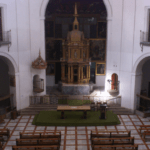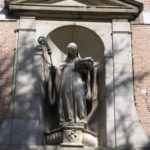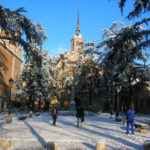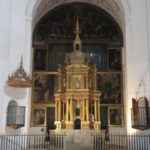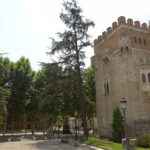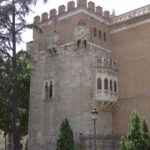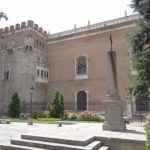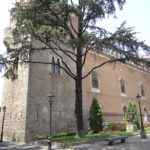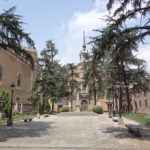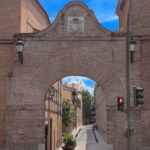Este texto también está disponible en español
Plaza de las Bernardas, together with Bernardas Convent and Archbishop’s Palace, make up one of the most special areas of Alcalá de Henares.
Plaza de las Bernardas is one of the most quiet and special places of Alcalá. With its stone banks and its wonderful trees, one of the most beautiful urban ensembles of Alcalá is compounded. Both the convent and the church of enclosed nuns—top work of Spanish Baroque which gave name to the square—are founded in there, between the Archbishop’s Palace and the Regional Archaeological Museum, and a few steps away from plaza de los Santos Niños, the Magisterial Cathedral and calle Mayor.
When the Cistercian convent of enclosed nuns of San Bernardo was created, twenty four nuns were part of it, and when it closed, at year 2000, there were six nuns remaining—who were moved to a bigger one. In several of the old convent stays, the Museo de Arte Religioso [Religious Art Museum] was allocated, filled with artistic jewels that will surprise you—not known until a few years ago but with a great visual presence, such as the wonderful Ark of the Emperor Charles V or the stunning armchair of the convent-founder archbishop.
Cervantes Patron
The monastery was founded in 1617 by the cardinal Bernardo Sandoval y Rojas, also Toledo’s Archbishop and General Inquisitor—highest Catholic charges of that time—, besides being a great patron for writers, as the very same Cervantes, Lope de Vega, Góngora, Quevedo or fray Luis de León experienced.
The building finished in 1636 was the last great work of the prelate, as he died in the following year. It was designed by the great architect Juan Gómez de Mora from Madrid—inspired by the canons of major Italian architects of that moment—and the work was carried out by the Alcalá’s maestro Sebastián de la Plaza. The whole compounded by the monastery and the church was set up into the old Moorish neighborhood of Almanjara, making some streets disappear and hiding one of the city doors, puerta de Burgos, which was moved into the vegetable garden of the convent and was substituted by the Arch of San Bernardo—leading today to the old highway from Madrid to Barcelona and to parque O’Donnell.
Bernardas’ Church has a sober façade that causes a certain impression of coldness due to its austerity. However, it intensely contrasts with the sight of the visitor entering to the church, very open, spacious and full of light. Regarding to the enclosure convent, there are two cloisters, the convent archive and the chapter house.
The Biggest Oval Dome of Spain
Entering into Bernardas’ Church is an surprising experience: the visitor will not only be immerse in a huge and tall nave—full of light from its dome seven large rounded windows, reflected by great white walls where it stands out several balconies and platforms from where nuns, prelates and court nobles attend to religious services—but will also observe its oval ground plan—an unusual shape for temples of that time, the same as the magnificent dome covering it, also oval, and which is the best of its genre constructed in Spain. The beauty of its dome is well worth the visit.
During the civil war, the convent was devoured by the flames of a big fire that damaged the adjacent Archbishop’s Palace. That fire caused the destruction of the dome, which in 1970 was completely restored, being based on its original design.
Surrounding the great central space, visitors will observe six small chapels, four being oval shaped and two squared. At the back, there is a wonderful canopy—or four faces polychrome wooden small temple on the altar—placed as an altarpiece—also an original contribution for that time—with paintings by the great artist Angelo Nardi.
Museo de Arte Religioso
The Museo de Arte Religioso [Religious Art Museum] was opened in January 1997, thanks to the discovering of the stairs by which the archbishop and his entourage went up from the temple to a passage. Currently bricked up, the corridor gave access to the platforms and aforementioned balconies surrounding the church nave, above chapels. It is in there and into the passage where the museum is placed, established in seven stays and a solitary confinement cell—which remains the same as when it was occupied by a nun.
The allocated stays are those of the founder, the stairs’, the chasuble one and that of the keys’ safe, the corridor of vocation letters, the catafalque, the founder paint stay and the kitchen. When the Museo de Arte Religioso [Religious Art Museum] was opened and during its first three years, nuns still living in there, and they always took care that fresh vegetables were present in the kitchen, like onions, garlic and laurel.
Nuns always had a great interest in preserving the rich heritage of the convent and church. After the Civil War, their concern led even to the recovering of some paintings, buying them by bringing down their food budget—with a great effort—during a long period of time.
The opening of Museo de Arte Religioso [Religious Art Museum] constituted an authentic happening for Alcalá’s inabitants and the rest of the world as, during several centuries, there a great number of pieces of great artistic and historical value had been kept secret and, since that moment, they could be put on show.
Charles V Ark
Museo de Arte Religioso [Religious Art Museum] not only holds valuable seventeenth-century paintings by maestro Angelo Nardi but also a wonderful black ebony ark totally covered by silver sheets which represents victorious scenes of Emperor Charles V—to whom the ark is dedicated by his son Philip II, who ordered its construction. Cardenal Cisneros remaining and ashes were kept into such ark until the plundering suffered during the Civil War, when they were moved to his crypt into Magisterial Cathedral.
An additional piece with great attractiveness is the armchair Cardinal Sandoval—founder of the convent—brought from Italy. A unique piece of its genre mixing woodwork—painted in gold—with jewelry, with incrusted crystals decorated as if they were precious stones. Besides, several documents telling the history of the four-centuries-old monastery, many religious objects from different periods, enormous paintings and so on might be appreciated: such as a facsimile of the Complutensian Polyglot Bible—another amazing project impelled by Cardenal Cisneros—or a beautiful sculpture of Immaculate Mary, by Antonio de Herrera Barnuevo.
Cardinal Sandoval y Rojas burial scene, recreated in one of the stays, turns to be especially interesting, as the painting faithfully reflects how there were seventeenth-century ceremonies: a catafalque or casket arranged for the wake and covered with a magnificent black velvet gown woven with silk, golden and silver threads. A beautiful image of a Cristo de la Cruz, by an anonymous author, and dating back from the same century is also present in there.
Finally, the door linking the convent with the Archbishop’s Palace was also recovered and brought to light after the opening of Museo de Arte Religioso [Religious Art Museum].
Additional Information:
Useful information:
- Address: Plaza de las Bernardas
- Monday to Saturday: 11:30, 12:30, 1:30, 5, 6 and 7 p.m.
- Visits service: +34 91 888 09 30
- Price:2,5 €
Access from Madrid
- Renfe Cercanías railroads C-1, C-2 and C7A.
- Bus nº 223 (departure from Avenida de América Interchanger).
Image gallery:
On video:
Where is it


